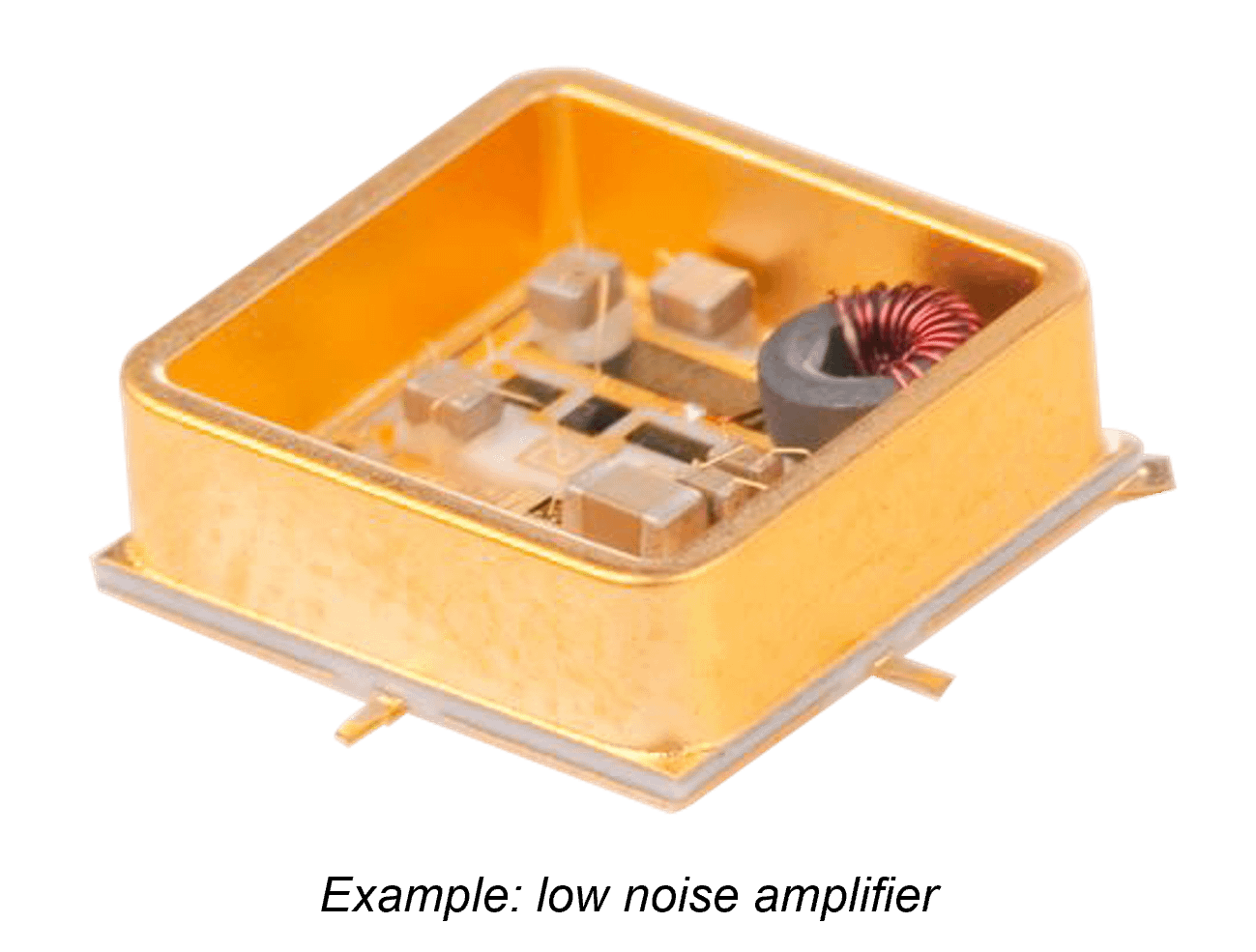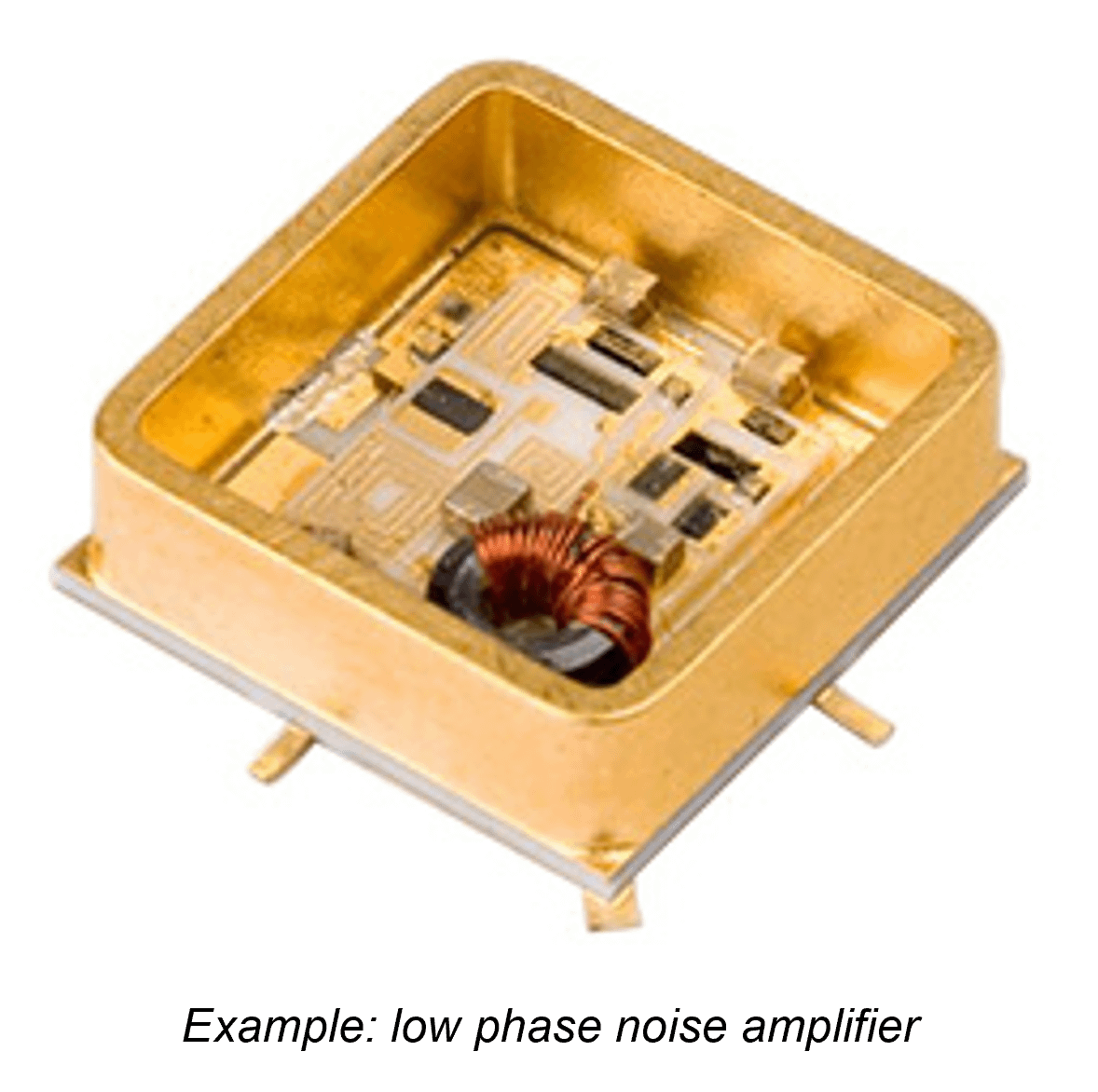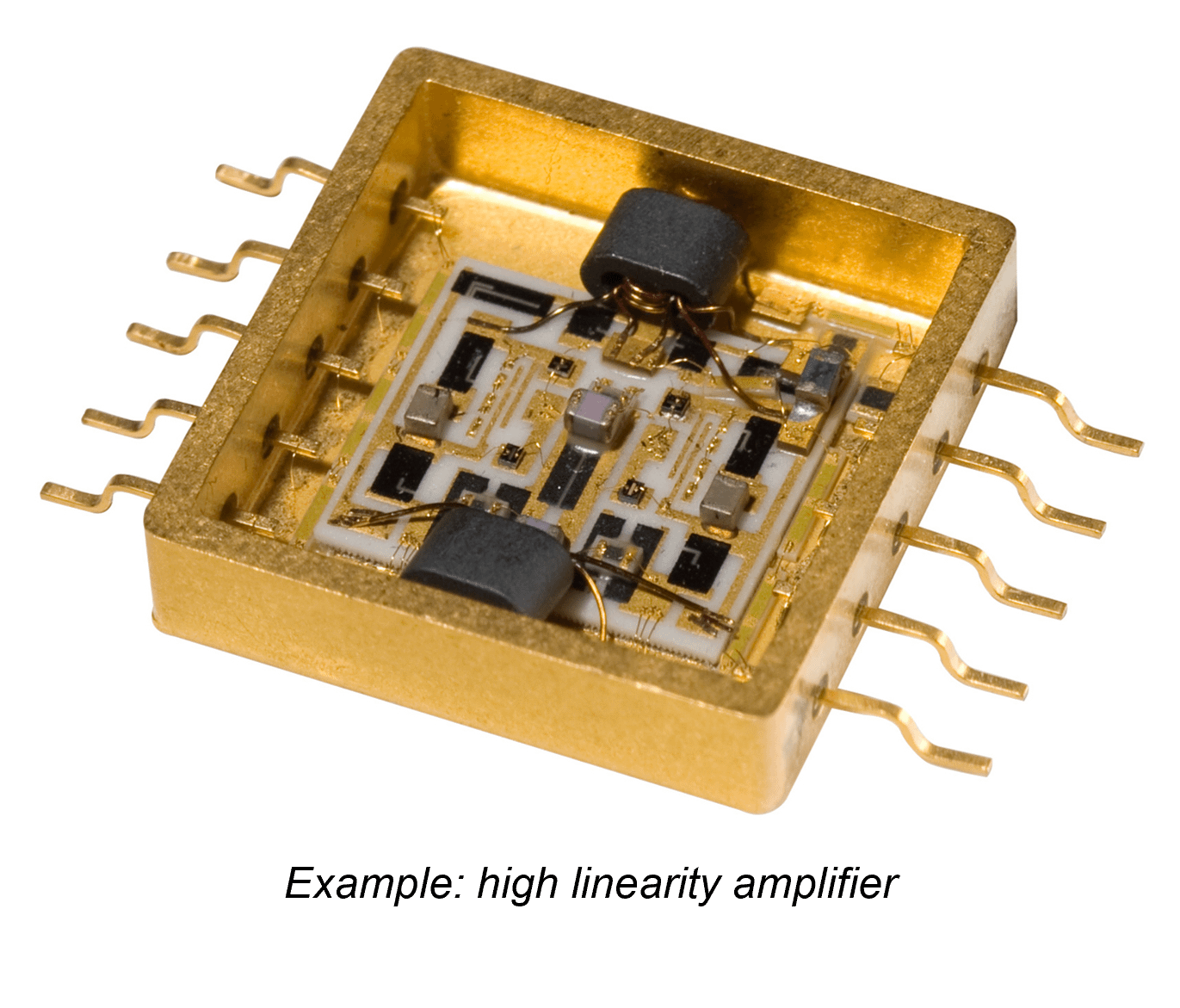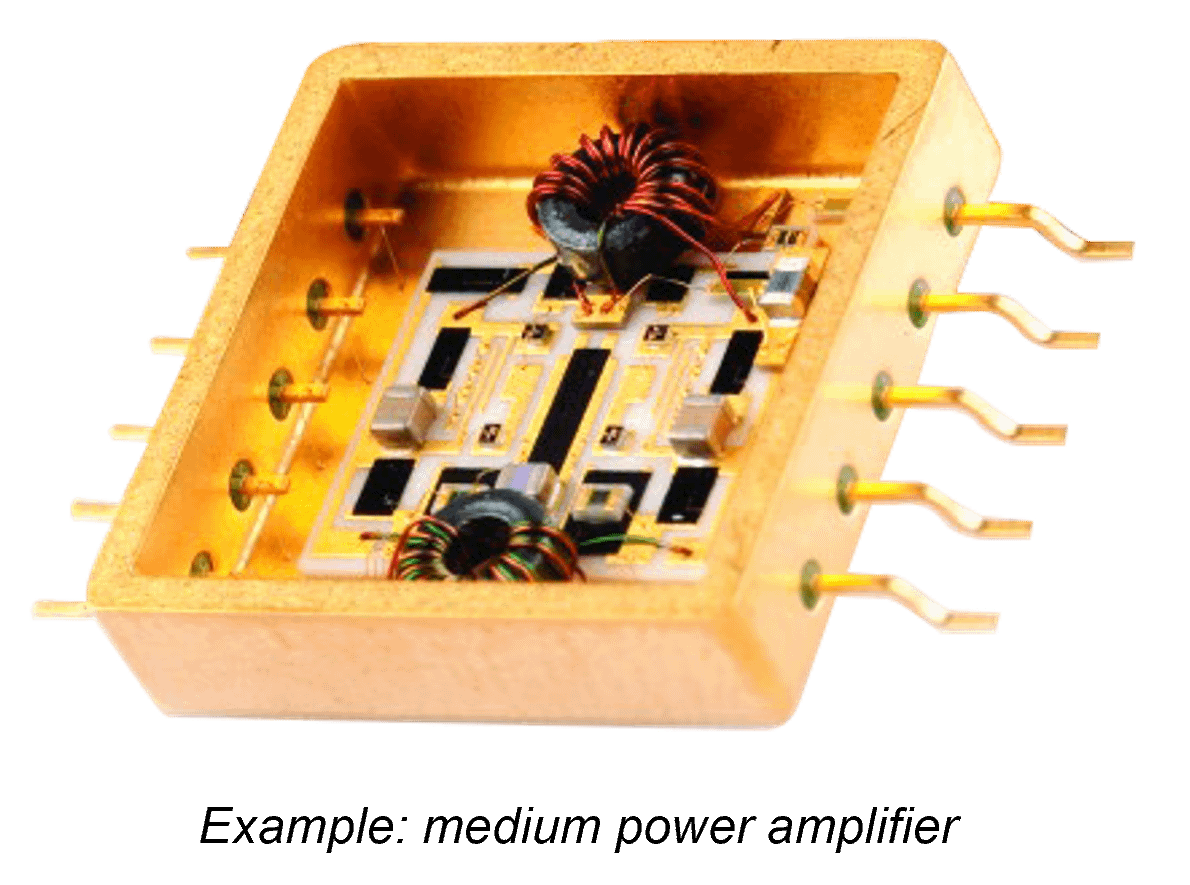What Is An RF Amplifier and How Does It Work?
A low noise RF amplifier, or radio frequency amplifier (LNA), boosts the power of RF signals. Hybrid low noise amplifiers are essential devices where high reliability is a key factor; applications ranging from transmitting radio signals to enhancing signal strength in wireless devices. They operate by taking a low-power RF signal and amplifying it using power from a DC power supply, resulting in a higher-power output signal.
RF chip and wire low noise amplifiers use a dc power supply to provide the energy needed for signal amplification. A low noise amplifier for example takes the input signal and, through the use of transistors, increases its signal strength, resulting in a stronger output carrier.
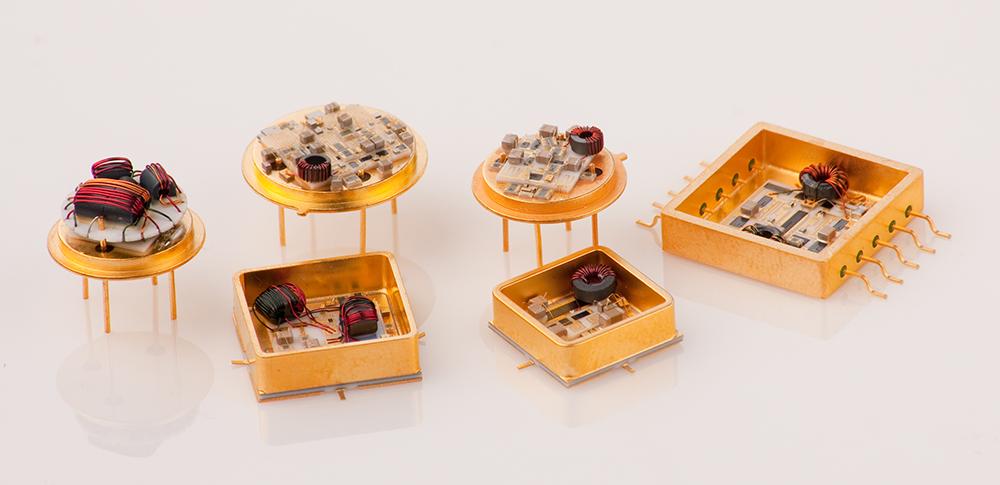
Why do I need an RF Amplifier?
RF chip & wire low noise amplifiers are crucial for reliably boosting weak RF signals making usable for transmission or processing. Low noise amps are essential for enhancing signal strength, improving the signal-to-noise ratio, and ensuring that signals reach their intended destination.
Signal Amplification
Radio frequency (RF) signals, particularly those received from antennas, are often very weak—sometimes measuring just a few milliwatts. Low Noise Amplifiers increase the strength of these weak signals to levels that can be utilized by other components in the RF chain, such as mixers or detectors. This RF amplification ensures that the signal is strong enough to be processed effectively.
Improving Signal-to-Noise Ratio (SNR)
Low noise amplifiers enhance the SNR by boosting the desired signal while reducing the amplification of unwanted noise. A higher SNR results in a clearer and more accurate LNA signal, which is essential for reliable communication and data transmission.
Overcoming Signal Attenuation
RF signals can lose strength as they travel through cables, connectors, and air. Low Noise RF amplifiers help counteract this loss by boosting signal strength, ensuring it arrives at its destination with adequate power.
Driving Subsequent Stages
In many RF systems, the output of one low noise amplifier stage drives another stage or component. RF low noise amplifiers supply the necessary power and signal strength to ensure the proper operation of subsequent stages.
Applications
- Defense radar: primarily for surveillance, target detection, and tracking in air and missile defense
- Missile systems: technologies designed for detecting, tracking, intercepting, and destroying incoming missiles
- Telemetry: automatic data measurement and transmission from remote sources
- Electronic warfare (EW): the use of the electromagnetic spectrum to conduct military operations
- Jammers: device that deliberately blocks or disrupts radio signals
- Interferometers: measurement instrument that utilizes the interference of waves
- SIGNINT: collecting and analyzing intercepted electronic signals
- Space: communications, deep space, scientific missions, launch and re-entry
Type of RF Amplifiers
Low Noise Amplifiers
A Low Noise Amplifier (LNA) is a device that boosts weak signals while adding minimal noise in the process. The main aim is to enhance signal strength without significantly reducing the SNR.
- Variety of package options: surface-mount, to connectorized housings, offered in wide variety of package options to fit unique requirements
- Exceptional performance: low noise amp noise figure values below 1 dB achieved through continuous improvements in products, processes and product teams
- EAR99 and RoHS compliant: versions available for rugged environments and worldwide export
Low Phase Noise Amplifiers
Low phase noise amplifiers are essential for many of today’s defense platforms that require spectral fidelity. Low phase noise amplifier performance is especially important in clock circuits and receiver front-ends where low phase noise amplifiers are critical, as those oscillators require higher output power without comprising the noise floor of the LO.
Better phase noise performance is a requirement often sought in today’s most advanced systems. Achieving guaranteed low phase noise performance by using a combination of design techniques, material selection, and in-house testing.
- Guaranteed phase noise performance: the expected level of phase noise from an amplifier, usually measured in dBc/Hz at a specific offset frequency from the carrier
- Improved spurious signal suppression: lower phase noise performance from an LNA means improved spurious signal suppression, making low phase noise amplifiers ideal for even the most challenging systems and requirements
- Better signal to noise ratio: better phase noise performance means a better signal to noise ratio, both typical and guaranteed phase noise
- Superior engineering: incorporating expert design techniques, careful material selection, and in-house testing in the development process can guarantee low phase noise performance
- Improved sub-clutter visibility: improved phase noise performance from Low noise amps means improved sub-clutter visibility all weather radar applications
High Linearity Amplifiers
High IP3 amplifiers are essential because they reproduce input signals accurately at their output. High IP2 Amp performance minimizes distortion and maintains signal integrity, which is particularly important in complex communication systems. Such performance is vital for ensuring accurate data transmission and preventing interference.
- High IP3 amplifier performance: the better the IP3, the more notable the receiver's ability to separate and discern several tones that are processed simultaneously inside the desired passband
- Superior signal integrity: a perfectly designed push-pull RF amplifier should cancel the internally generated products and maintain signal quality
- High intermod amps: push-pull techniques help cancel even harmonics as well as intermods and helps to improve even-order intermods products
- Exceptional performance: medium Power amps include designs with IP2 values better than 100 dBm
Medium Power Amplifiers
A medium power RF amplifiers are designed to enhance signal strength with a moderate output power level. These medium power amplifiers are utilized in various applications where higher signal power is required compared to what typical low noise amplifier or low power amplifier can provide, but not to the extent of a high power amplifier.
- Medium output power amps: Offers output power up to a few watts, depending on the specific application and design
- Medium power amp gain options: these amps offer a moderate gain level, meaning they amplify the input signal by a specific output power, but not as aggressively as high gain amplifiers
- Fills the gap: between low and high power amplifiers, offering a balanced combination of signal strength and linearity
Space Qualified Amplifiers
- Space qualified amps: access to over 1000 space qualifiable standard designs as well as custom solutions designed to withstand the most extreme environments
- Class H & K manufacturing: deliver space screening options and qualified solutions designed to withstand the harsh environment of space
- Vital space system: high performance and reliability products for mission-critical applications
Additional Resources
Explore Spectrum Control's RF Amplifiers
- Low Phase Noise Amplifiers
- High Linearity Amplifiers
- Low Noise Amplifiers
- Medium Power Amplifiers
- Space Qualified Amplifiers
